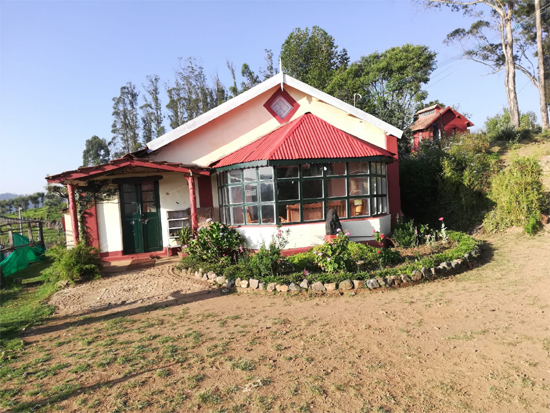

The year 2023 marks a hundred years of Narayana Gurukula, established by Nataraja Guru in Ooty, Tamil Nadu, India, on 8th June 1923 to follow the wisdom lineage of Narayana Guru. Narayana Gurukula celebrates this with year-long programs across the world. In this context, this essay attempts to sketch a brief history of the Narayana Gurukula and its contribution in disseminating the perennial Wisdom tradition of Guruhood.

ONE

Origin of Narayana Gurukula
Dr. P. Natarajan (1895-1973), the 3rd son of Dr. Palpu, who contributed to the Kerala Renaissance, took discipleship from Narayana Guru and founded the Narayana Gurukula. At the request of Narayana Guru, Dr. Palpu gave his son to the Guru to join as a disciple to carry out the efforts he had initiated. Natarajan completed his MA in Zoology, Geology, and LT from Madras University, took Guru’s discipleship, and joined the Advaita Ashram at Aluva in August 1922. Due to many reasons (details can be found in Nataraja Guru's Autobiography, Autobiography of an Absolutist, DK Print World), Natarajan couldn’t continue at Aluva. Fully realizing the situation, Narayana Guru advised him to go elsewhere and start exploring projects which are in line with his Svadharma. He reached Coonoor and stayed with Bodhananada Swami, one of the foremost disciples of Narayana Guru. Using his academic background and the educational vision of Narayana Guru, Natarajan planned to set up a residential school. It was envisaged as a model school for boys below 18 years of age in line with the Upanishadic tradition by adopting values from Eastern and Western traditions and vocational training. The educational philosophy was formulated with a student-centered education, learning through doing, Dalton's method, and Garry's plan, combined with the educational philosophies of Socrates, Dewey, Froebel, Tolstoy, and Rousseau. The ancient Indian educational system of the Gurukula School of Education, based on the intimate rapport between the teacher and the taught, was to be the foundation of this model school. With the help of a press owner in the Nilgiris, he got a prospectus printed. With this, Natarajan started the “Narayana Gurukula” school in an abandoned tea factory at the Cleveland estate owned by Ramaswamy Pillay, a devotee of Narayana Guru. When Narayana Guru permitted Natarajan to start Narayana Gurukula, the Guru insisted on three guidelines to be followed:
- Gurukula should be a place where Guru and disciples, like the father and children in a natural family.
- Marriages should not be obstructed.
- The whole world should become the “Gurukula”.
Though the Gurukula was established with a grand vision, it couldn’t succeed as planned due to a severe financial crisis. The students and the teacher had to endure many hardships to earn their daily bread, including performing street plays and begging. These are described in detail in Nataraja Guru's Autobiography. Despite these hurdles, the students celebrated the first anniversary of Narayana Gurukula on 8th th June 1924 with various cultural programs. Then minister, Sir. A. P Patro, presided over the meeting. Justice Sir T. Sadasiva Iyer (a householder disciple of Narayana Guru), Dr. James S Cousins, and Dewan Bahadur K.S. Ramaswamy Sastry graced the occasion. Various newspapers, including the Hindu, covered this event well, but it didn’t help improve the school's financial condition. Therefore, the school functioned from multiple makeshift locations, and the search for a permanent campus continued. This led to the procurement of 4 acres of land at Fernhill (where the present Gurukula is situated) from the Government through a down payment of a certain amount and the promise of paying the remaining amount as rent for an indefinite number of years.
On June 13, 1926, at 3.30 PM, on this land, the foundation stone for the Narayana Gurukula building was laid by the young Maharajah of Travancore, Sri ChithiraThirunal Balarama Varma. Along with this, the 3rd anniversary of Gurukula was celebrated. The meeting was presided by Sir C.P Ramaswamy Iyer, who later became Diwan of Travancore. This is the meeting in which the Travancore King gave his maiden speech at a public function. Maharani of Travancore, the Raja of Boibli, and the King's tutor Dr. W. Dodwell attended the function. However, the Gurukula faced dire challenges due to the lack of funds, the student's internal feuds, and a chicken pox attack. This led to severe mental stress for Natarajan, forcing him to wind up the first Gurukula experiment. He returned to Varkala and, as per the instruction of Narayana Guru, took over the temporary post of headmaster of Sivagiri English School, which was established by Guru himself. In 1927, in the absence of Natarajan, Narayana Guru visited Ooty in1927 and enquired where the foundation stone was laid for the Gurukula. He reached the location and, after viewing the place, commented that this place was like heaven. Natataraja Guru says in his Autobiography, “Although he did not set foot on the land, even the glance that he gave to it is treasured by this humble disciple to this day, as an act of extreme grace and compassion towards me.”

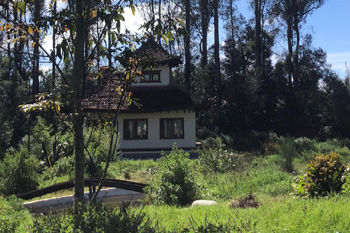

Social Acceptance of Nataraja Guru’s Guruhood
In 1926, while visiting Ceylon (Sri Lanka), Narayana Guru gave a yellow shawl to Natarajan as a symbolic gesture of ordaining him as a Brahmacharin. In May 1928, Natarajan was sent abroad for higher studies by Narayana Guru, with his blessings and financial assistance. After completing his D.Litt. (thesis title: "The Personal Factor in the Educative Process") with triple honors from Sorbonne University, Paris, and M.R.S.T from London, Natarajan returned to India in May 1933. Like in his father's case, he was denied a Job in Travancore and neglected by both the Sree Narayana Dharma Sangham, which Narayana Guru had established as a monastic order, and S.N.D.P. Yogam, which was set up to propagate the way of the Guru. After that, he returned to Fernhill and revived the Gurukula, and continued his life mission of disseminating the wisdom teachings of Narayana Guru.
On April 16, 1951, a meeting was held at the Sasi Theatre, Varkala, presided by the then SNDP Yogam president Dr. P.N. Narayanan and attended by locals and Sannyasins of Sivagiri Mutt and members of other Sree Narayana Guru organizations, where a resolution was passed, accepting Dr. P. Natarajan as the successor of Narayana Guru in the Guru lineage and would henceforth be called Nataraja Guru. On the 1st of January 1956, after the age of 60, Nataraja Guru took up sannyasa and saffron robes (ochre) in front of a photograph of Narayana Guru in the traditional way. Narayana Gurukula Foundation was established with its headquarters at Varkala, and a will and a testament were registered on February 24, 1959, appointing John Spiers (disciple of Nataraja Guru), Swami Mangalananda, and Nitya Chaitanya Yati as the successors in the Guru lineage. However, Mangalanda Swami attained samadhi in 1967, and John Spiers left the Gurukula in 1971 due to personal reasons. Therefore, after Nataraja Guru’s samadhi on 19th March 1973, Nitya Chaitanya Yati became the Guru and Head of the Narayana Gurukula Foundation. Guru Nitya attained samadhi on May 14, 1999, and then Muni Narayana Prasad became the head and current Guru. As per the will of Guru Muni Narayana Prasad, Swami Tyageeshwaran, Swami Tanmaya, and Swami Mantra Chaitanya (heading a center in Fiji) come in the lineage. Apart from Varkala, Gurukula has centers in Fernhill (Ooty), Tholpetty, Vaithiri, Periya, Kanakamala, Kuyyali, Cheruvathoor, Edappally, Malayattoor, Thottuva, Thrippunithura, Engadiyoor, Palakkazhi, Veezhumala, Vakayar, and Ochira. Gurukula has centers in Bangalore, Chennai, as well as in Bainbridge Island, WA., Portland, OR. (USA), and Fiji. (You can view the locations of the Narayana Gurukulas across the world in the Lokam Maps).

Guru Nitya, Nataraja Guru & Swamy John Spiers
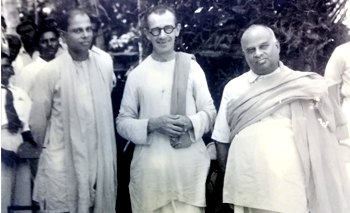
Mangalananda Swamy, John Spiers & Guru

TWO

To find everlasting happiness in one’s life through unitive understanding, as per wisdom texts (srutis), Gurukula follows Nivritti Marga (path of wisdom). For this, in-depth studies are conducted on the Philosophy of Narayana Guru through Guru’s works and the philosophies of other Gurus across the globe, along with works of Eastern and Western philosophers and findings of modern science. The wisdom gained from all these is transmitted to the resident disciples of Gurukula, and typically, the transcripts of such classes are published as printed books for broader dissemination and the benefit of future generations. In recent times, in addition to print media, the possibilities of electronic media have also been utilized for this purpose.
The Gurus of Gurukula had recorded in Malayalam and English the objectives of Gurukula and the values it upholds. Though no significant financial earnings exist, Gurukula prints and publishes books in attractive formats. Also, Gurukula developed and used a unique methodology and lexicon in their publications. Guru Nitya succinctly expresses this in his autobiography Love and Blessings “During the last thirty years, the Gurukula has produced a literature of its own which stands markedly different from anything thought of, written, or presented by anyone else. I cannot adequately thank Nataraja Guru for his wisdom in programming such a course of studies, which has been elaborated year after year. It is an ever-growing wisdom heritage that commenced with the publication of Values in 1955 in Bangalore and Gurukulam Magazine in Varkala shortly thereafter." (Love and Blessing, page 165, Published by Narayana Gurukula in 2000).

Book publishing history of Narayana Gurukula
Though Nataraja Guru, Guru Nitya Chaitanya Yati, and Guru Muni Narayana Prasad used to spend dedicated time for writing books, toward the later part of their life, they used to conduct structured classes for Gurukula inmates, who wrote down and submitted them to the Gurus for scrutiny. After re-reading the same, necessary corrections and edits were made and used for publishing as books. Guru Nitya, John Spiers, and Guru Muni later described the hard work they had to put in to adopt this approach initially developed by Nataraja Guru. Guru Nitya and Guru Muni also prepared the English editions of their Malayalam works. Rather than doing word-by-word translations, depending on the subject matter with the use of unique writing skills, they made independent English editions of those books. Therefore, the English books of these Gurus stand apart from the traditionally translated works.

Works of Nataraja Guru
The publishing history of Narayana Gurukula started with the publishing of The Way of The Guru, written by Nataraja Guru in 1942. The first 9 Chapters of this book were serialized as “Way of the Guru” in 1928 in the Sufi Quarterly, published in Geneva while Narayana Guru was alive.
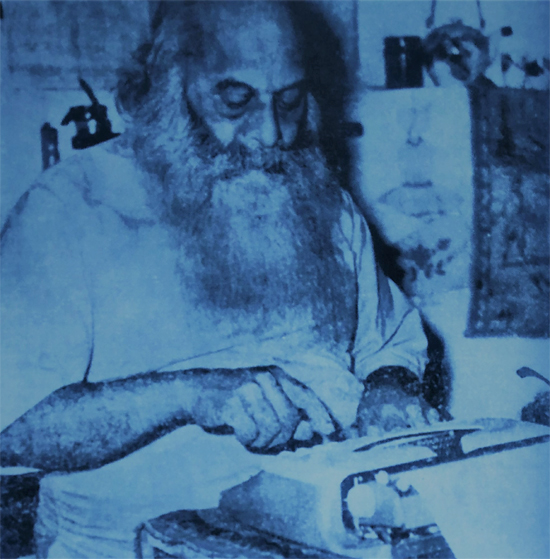
Guru at work in Fernhill Gurukula - 1965
They were collated and published as a book in 1931 from Geneva, and an Indian edition was published in 1942. After 20 years of study and contemplation, the 2nd and 3rd parts of the book were written and completed during Nataraja Guru's trip to New York in the year 1948 to 1951. The draft was thoroughly read and edited by John Spiers. Nataraja Guru writes in the introduction that his writing style was opposite to the type of occult journalistic style and due to which a major publisher in London rejected its publication. The author also had no commercial interest in publishing the book. This tells about the style and content of the book. Nitya Chaitanya Yati mentions in his Autobiography that to pay the debt to the printer and to burn the cooking stove in the Gurukula, he had to go around and sell this book to many whom he knew wouldn’t read the same.
In 1961, Asia Publishing House, Bombay, published an elaborate commentary on Bhagavad Gita by Nataraja Guru. In 1968, the second edition of The Word of the Guru was published by Paico Publishing House Ernakulam. (This coincided with Nataraja Guru's birthday, and the publisher, Mr. Pai, brought the first copy himself via air to Bangalore.) In 1969, Narayana Gurukula published Nataraja Guru's Translation and Commentary of Narayana Guru’s Atmopadesa Satakam as One Hundred Verses on Self Instruction. This was initially serialized in Values magazine, the English mouthpiece of Narayana Gurukula. Nataraja Guru could only witness the publication of those three books during his lifetime.
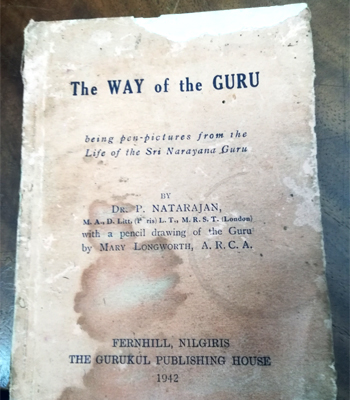
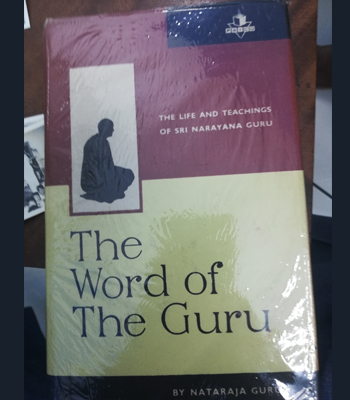

Publishing House of Narayana Gurukula
On September 11, 1955 (the birth centenary of Narayana Guru), the Gurukula mouthpiece Values started publishing from Bangalore under the editorship of John Spiers. The articles written by Nataraja Guru, John Spiers, and Nitya Chaitanya Yati there over two decades helped to introduce Narayana Guru and his wisdom teachings to people of various backgrounds across the globe. The currently available books of Nataraja Guru, except for the Word of the Guru, Bhagavad Gita, and An Integrated Science of the Absolute, were first serialized in Values magazine. By keeping the Gurukula students in mind, Nataraja Guru prepared a study plan comprising Eastern and Western philosophy, Economics, Education, Law, and World Government and wrote several articles on these subjects, published in Values. Later they were compiled based on the subject matter and published as books titled Vedanta Revalued and Restated, The Philosophy of a Guru, The Search for a Norm in Western Thought, Towards a One World Economics, and World Education Manifesto. John Spiers pursued Nataraja Guru to write articles for every issue of Values. In the introduction to his Autobiography (An Autobiography of an Absolutist), Nataraja Guru wrote that it was in response to John’s threat that John would write a biography, and he didn't want someone to speculate and write about his life. That way, John successfully extracted wisdom teachings from Nataraja Guru. Nataraja Guru also wrote a Memorandum on World Government, which was used by the World Service Authority established by Garry Davis, who served in the U.S. Army during the Second World War as a B-17 bomber pilot.
In addition to articles on Narayana Guru and his philosophy, other subjects which add value to human upliftment were also given equal importance in the Values magazine. These include art, literature, poetry, Eastern and Western philosophy, history, and subjects not typically discussed in other periodicals, such as anthropology and psychology. Whatever be the content of an article, as an editor, John was able to infuse his unique style in terms of language and presentation. The other features include the publication of pre-announced theme-based issues, including page numbers in a serialized manner to make future finding possible, etc. The magazine had 32 pages and was printed in demy ⅛ size with central stapling. The magazine suffered from the struggles faced by parallel publishing houses, like financial crunch and lack of technological and marketing support. When John went abroad for 14 months in 1961-62, Nitya Chaitanya Yati was entrusted as the editor of the magazine. One can read the difficulties faced in publishing this magazine in his autobiography. The magazine continued its publication till June 1974.
The Malayalam mouthpiece of Narayana Gurukulam, titled Gurukulam magazine, started publishing in January 1953 from Varakala under the editorship of Mangalananda Swami. Though its publication got halted in between for a short period, till now, it has continued as a philosophical magazine for the last several decades. In the earlier days the subscriptions covered the publishing cost. At various intervals, the magazine was edited by Guru Nitya Chaitanya Yati, Guru Muni Narayana Prasad, Swami Mantra Chaitanya, and K.P Ramakrishnan. The current editor is Swami Tyageeshwaran. In addition, an English edition of Gurukulam used to be published from 1985 till 2013 from Bainbridge/Portland Gurukula USA under the editorship of Nancy Yielding and Deborah Buchanan, the American disciples of Guru Nitya.
In the beginning, Values and Gurukulam Magazines were printed at private presses. Only in 1974 could Gurukula establish a printing press in Varkala named Magala Press in memory of Mangalananda Swamy. In addition to the printing of Gurukulam magazine, certain books of Nataraja Guru, Guru Nitya, and Guru Muni are printed in this press. Guru Muni's Nyaya Darsanam is the first book printed in the Mangala press.
Since the beginning, the translation of Nataraja Gurus works like The Word of the Guru, One Hundred Verses on Self Instruction, and An Autobiography of an Absolutist by Guru Nitya Chaitanya Yati, Mangalananda Swami and Guru Muni have been serialized in the Gurkulam magazine. Once completed, they were collated and published as Malayalam Volumes with titles Guruvarul, Atmopadesa Satakam, and Nataraja Guruvinte Atma Katha (4 volumes), respectively. Guru Nitya’s Bhagavad Gita's commentary was also serialized first in the magazine and later published as six volumes, each covering three chapters. Nataraja Guru's magnum opus, An Integrated Science of the Absolute, using Darsana Mala as its base, which portrays Brahmavidya as the science of sciences, was published by Narayana Gurukulam in 1979. In 1970 and 1971, Nataraja Guru organized the "World Conference for Peace Through Unitive Understanding" at the Ezhimala Gurukula (Kannur, Kerala). The proceedings of this conference, edited by Curran A. de Bruler (Nataraja Guru's disciple), were published as “Unitive Understanding Vol I & II” with forewords by Nataraja Guru. The first volume was published in 1970 and carries the address of Gurukula Island Home, Ramanthali, Kannur, and the second volume was published in 1973 and bears the address of Gurukula Institute of Aesthetic Values, Narayana Gurukula, Somanahalli, Bangalore. In addition, the English translation of 19 works of Narayana Guru by Nataraja Guru, titled An Anthology of the Poems of Narayana Guru, was published in 1977 from Bangalore. Narayana Gurukula, Varkala, published subsequent editions of many of these books. In this way, slowly and steadily, the book publishing endeavor of Narayana Gurukula expanded, and the distribution was done through the outlets associated with the Gurukula centers, the main being one at Varkala.
In 1987, Mr. Gangadharan, a household disciple of Nataraja Guru and Guru Nitya, donated a large sum to Gurukula by selling his share of family property. This money was utilized to publish Nataraja Guru's books which were unable to be published due to financial crunch, and also used for publishing the new edition of some of the Gurukula books. These books were printed at All India Press, Pondicherry (Sri Aurobindo Ashram), which was then one of the finest printing presses in South India under the supervision of Swami Vyasa Prasad (the current Head of Narayana Gurukula, Fernhill). The books published during this way include The Life and Teachings of Narayana Guru (A combined edition of The Word of the Guru and One Hundred Verses of Self Instruction), Autobiography of an Absolutist, Bhagavad Gita Commentary, and translation and commentary of Saundarya Lahari. Guru Nitya’s books, like Love and Devotion and Psychology of Darsanamala, were also published during this time. All these books were published under Narayana Gurukula Publishing House, Varkala, and distributed through its channels.
In the late 1980s, Mr.Rai Mittal, the owner and publisher of DK Printworld, New Delhi, approached Guru Muni Narayana Prasad and introduced himself as the publisher of philosophical/ and cultural books in English and Hindi and told him that he was searching for new manuscripts. Guru Muni gave him two manuscripts (Karma and Reincarnation and English commentary of Taittiriya Upanishad), almost ready for publication. Within a short time, Mittal printed and published them excellently, which the readers and book distributors received well. Later they contacted Guru Nitya, who gave them a few books, including his English commentary on Bhagavad Gita, for publication. During this time, Mr. Susheel Mittal, son of Mr.Rai Mittal, took charge of the business and expanded his business while retaining the quality of the publications. After that, they started publishing more works of Guru Muni, Nataraja Guru, and Guru Nitya, one by one. They produced all of them in excellent quality, sold them widely, and imbibed enthusiasm for Gurukula publications to readers. They were also made available on online platforms for domestic and international buyers. DK Print World has now become a major publishing partner for Gurukula books, and they published close to 40 titles so far.

Works of Guru Nitya Chaitanya Yati
From the beginning of the publication of Gurukulam Magazine, Guru Nitya used to write articles on various subjects of human interest there. Later he translated the first part of Nataraja Guru’s, The Word of the Guru (Guruvarul) and the first 26 verses of Atmopadesa Satakam Commentary and published them in Gurukulam magazine. In 1968, Gurukula published Guru Nitya’s first Malayalam book Guruvarul. In 1960, his first English book, An Intelligent Man's Guide to Hindu Religion, was published with a foreword by John Spiers. Since then, a few other English and Malayalam books of Guru Nitya have been published by Narayana Gurukula. A meditative commentary of Atmopadesam titled Neither this Nor That, but AUM, written during his stay in Portland, USA, and published in 1982 by Vikas Publishing House, New Delhi. In 1983, they also published the English commentary on Bhagavad Gita, a compiled version of the lectures delivered at Portland State University.
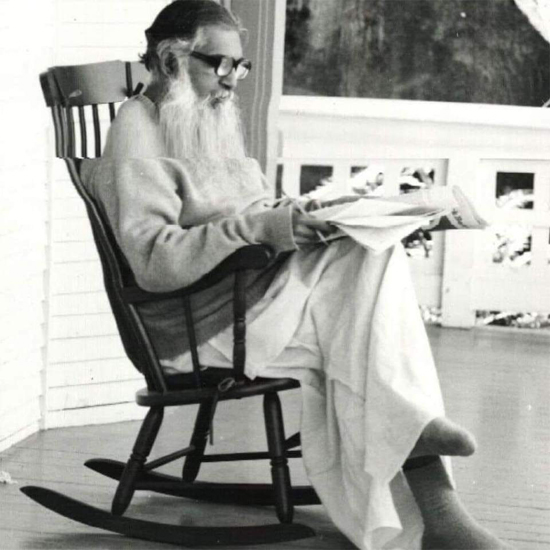 Apart from independent works, Guru Nitya also wrote commentaries on Narayana Guru’s major works, The Bhagavad Gita, Upanishads (Isavasyam, Brihadaranyaka), Gita Govinda, Saundarya Lahari, Vivekachoodamani, parts of Rig Veda and The Koran. Malayalam translations of some philosophical and literary works (e.g., Tagore’s Gitanjali, Khalil Gibran's Jesus the Son of Man, and Memoirs of Pablo Neruada, The Memoirs of a Dutiful Daughter of Simone de Bauvior), all of which account for over 100 Malayalam Books and 30 English books till today. His book Nalini Enna Kavya Silpam, based on Kuman Asan’s legendary poem “Nalini,” won the Kerala Sahitya Academy Award of 1977. D.C. Books, Kottayam Kerala in 1983 published this book, the first Malayalam book of Guru Nitya, published by a private publisher. Guru Nitya also wrote innumerable articles on Literature, Art, Philosophy, Vedanta, Psychology, Sociology, and Education, both in English and Malayalam, for various newspapers and periodicals. During the last 20 years of his worldly existence, he has been the most sought-after writer in Kerala for various journals and newspapers. He had a considerable readership, cutting across ages, castes, and creeds. Compilation of some of those articles based on subjects was later published as books by the Gurukula and a few publishing houses in Kerala, which are still being sold widely along with his other books. Many such articles are yet to be compiled. In the 1990s, some of his works were published on the label of Nitya Books, Fernhill, and Ooty, but later, they were reprinted from Varkala Gurukula. In 2005, the Indian Council of Philosophical Research (ICPR) Published an elaborate monograph on Narayana Guru written by Guru Nitya. It was “a clear exposition of the integral vision and the total philosophy of Narayana Guru.” The collection of selected letters written by Guru Nitya in Malayalam to people from all the strata of society was published by Narayana Gurukula in three volumes after Guru Nitya’s Samadhi. A combined volume of the same was published in June 2023 by Nityanjali Books. A compilation of the introductions he wrote for other authors in Malayalam and English is also in the pipeline. Similarly, the selected English letters of Guru to various people across the globe form a significant part of his autobiography “Love and Blessings,” published by the Portland Gurukula.
Apart from independent works, Guru Nitya also wrote commentaries on Narayana Guru’s major works, The Bhagavad Gita, Upanishads (Isavasyam, Brihadaranyaka), Gita Govinda, Saundarya Lahari, Vivekachoodamani, parts of Rig Veda and The Koran. Malayalam translations of some philosophical and literary works (e.g., Tagore’s Gitanjali, Khalil Gibran's Jesus the Son of Man, and Memoirs of Pablo Neruada, The Memoirs of a Dutiful Daughter of Simone de Bauvior), all of which account for over 100 Malayalam Books and 30 English books till today. His book Nalini Enna Kavya Silpam, based on Kuman Asan’s legendary poem “Nalini,” won the Kerala Sahitya Academy Award of 1977. D.C. Books, Kottayam Kerala in 1983 published this book, the first Malayalam book of Guru Nitya, published by a private publisher. Guru Nitya also wrote innumerable articles on Literature, Art, Philosophy, Vedanta, Psychology, Sociology, and Education, both in English and Malayalam, for various newspapers and periodicals. During the last 20 years of his worldly existence, he has been the most sought-after writer in Kerala for various journals and newspapers. He had a considerable readership, cutting across ages, castes, and creeds. Compilation of some of those articles based on subjects was later published as books by the Gurukula and a few publishing houses in Kerala, which are still being sold widely along with his other books. Many such articles are yet to be compiled. In the 1990s, some of his works were published on the label of Nitya Books, Fernhill, and Ooty, but later, they were reprinted from Varkala Gurukula. In 2005, the Indian Council of Philosophical Research (ICPR) Published an elaborate monograph on Narayana Guru written by Guru Nitya. It was “a clear exposition of the integral vision and the total philosophy of Narayana Guru.” The collection of selected letters written by Guru Nitya in Malayalam to people from all the strata of society was published by Narayana Gurukula in three volumes after Guru Nitya’s Samadhi. A combined volume of the same was published in June 2023 by Nityanjali Books. A compilation of the introductions he wrote for other authors in Malayalam and English is also in the pipeline. Similarly, the selected English letters of Guru to various people across the globe form a significant part of his autobiography “Love and Blessings,” published by the Portland Gurukula.

Works of Guru Muni Narayana Prasad
Guru Muni confesses in his autobiography (Atmayanam in Malayalam) that after becoming the editor of Gurukulam magazine, he was forced to write to fill the magazine's content, which made him a writer. For this, first, he started translating the works of Nataraja Guru and Nitya Chaitanya Yati. To go into the depth of work, he also developed a habit of either writing the commentary or translating the existing commentary from English. These writings were first serialized in the Gurukulam magazine, and after their completion later published as books. Nyadarsanam in Malayalam was his first published book. After that, he published more than 100 Malayalam and English books, including commentaries and translations. He is the only Sanyasin who comes under the Narayana Guru lineage to write commentaries on all the currently available works of Narayana Guru. In 2019 DC Books published it in 3 volumes.
 Poornajanam in Malayalam is the first book of Guru Muni Narayana Prasad, published by an outside publisher. DC Books published this in March 1989. Following this, his several books were published by DC Books, Mathrubhumi Books, National Book Trust, and Kerala Bhasha Institute. Most of his English books are free translations of Malayalam books published earlier. Apart from Narayana Guruula, English books were published by DK Printworld New Delhi and National Book Trust India. The Malayalam translation of Nataraja Guru’s Saundarya Lahari commentary won the best book for translation, and Atmayanam won the best autobiography award from Kerala Sahitya Academy.
Poornajanam in Malayalam is the first book of Guru Muni Narayana Prasad, published by an outside publisher. DC Books published this in March 1989. Following this, his several books were published by DC Books, Mathrubhumi Books, National Book Trust, and Kerala Bhasha Institute. Most of his English books are free translations of Malayalam books published earlier. Apart from Narayana Guruula, English books were published by DK Printworld New Delhi and National Book Trust India. The Malayalam translation of Nataraja Guru’s Saundarya Lahari commentary won the best book for translation, and Atmayanam won the best autobiography award from Kerala Sahitya Academy.

Contributions of Narayana Gurukulam Publishing House
In the domain of Narayana Guru literature, Narayana Gurukula published close to 300 books in Malayalam, English, Sanskrit, and Hindi. Apart from this, independent commentaries of ten major Upanishads (both in Malayalam and English) and the Bhagavad Gita commentaries by all the three Gurus in the lineage are the unique contributions of the Narayana Gurukula. Gurukula also published commentaries of Saundarya Lahari and Patanjali's Yoga Sutra. Other noble books published by Narayana Gurukula include a collection of the complete works of Magalanda Swami (Magalabharati), the prayer book of Gurukula titled “Gurukula Dhyana Manujsha” (A Bouquet of Meditation in English translated by Vinaya Chaitanya), a translation of Vedanta Paribhasha of Dharmaraja Adhvarindra in Malayalam by Guru Muni Narayana Prasad, Malayalam commentary of Astavakra Gita, Swami Chidmabara Theertha’s Guruvum Vacanavum (Life and sayings of Nataraja Guru), Dr. S. Oman’s doctoral thesis Philosophy of Narayana Guru, the detailed biography of Narayana Guru in Malayalam titled Oru Mahaguru, poetry collections of Swami Thyageeswaran, Njanavasishtam of Kavungal Neeknta Pillai, Malayalam translation of Jayadeva’s Gita Govindam titled Jayadevageetham.
Another salient feature of the Narayana Gurukula is that all four members of the Gurukula lineage had written autobiographies - Nataraja Guru’s Autobiography of An Absolutist, Guru Nitya’s Love and Blessings (in English and its Malayalam version Yaticharitham), Guru Muni's Atmayanam. John Spiers has written a detailed autobiography titled World of Memory - An Autobiography. This incomplete work of 44 chapters up to the age of 54 (he passed away at the age of 72) was serialized in the Values magazine from 1970 to June 1974. It was never compiled in a book form.

THREE

Narayana Guru’s Work in English and Gurukula Contributions
Till today, more than 60 works of Narayana Guru in Malayalam, Sanskrit, and Tamil have been found, and the commentaries are made available by Gurukula and a few other authors. Most works are poems, and Guru's poetic brilliance surpasses any great poet in any language. Guru has used unconventional meters, metaphors, and word compositions with ease in his lyrical compositions. Unlike the themes handled by other poets, Guru conveyed deep and complex philosophical messages and conclusions through his poems. Therefore, these works don't yield easy translations. Only those who have delved deeply into Guru’s philosophy, not as an academic subject but as an experiential science by contemplation, at least to some extent, understand the inner meanings and could translate them into other languages. Therefore, only limited attempts have been made to translate Gurus' works into English and other languages.
Nataraja Guru was the one who made the first attempts to translate Guru’s works into English. But he could complete them only after 30 years of study and contemplation. The 3rd part of The Word of the Guru, published in 1952, carries the translation and brief commentary of 7 poems of Narayana Guru. It also mentions the reason for selecting them. Later Nataraja Guru translated 13 more works into English The extract of literary translations of 20 poems from this book was published separately with the title An Anthology of the Poems of Narayana Guru in 1977. Later several editions of this book were published by Gurukula.
Guru Nitya translated and wrote commentaries on eight works of Narayana Guru, many of which were later published as books. Guru Muni Narayana Prasad translated 52 works of Narayana Guru and wrote commentaries on eight works. The translation titled Narayana Guru: Complete Works was published by National Book Trust India in 2016 as a single volume for the first time. The contents were categorized into Hymns, Philosophical works, and works of Moral Import.
The recent advent in this direction is the publication of the translation of 56 works of the Guru titled A Cry in the Wilderness - The Works of Narayana Guru by Vinaya Chaitanya, a disciple of Nataraja Guru. This is an outcome of 35 years of study and meditation without losing the poetic beauty and mystical dimensions of Guru's writings. This was widely reviewed and received well by both academics and Guru devotees. (Click this link for a Review by Dr.Kumar Rajappan (Vasanth). Vinaya Chaitanya also translated Narayana Guru’s Complete Works into Kannada, published by Insight Publica, Kozhikode. Owing to their inner depth and poetic dimension, Narayana Guru’s works open up new possibilities for future translations.

Acknowledgment
The authors are grateful to Sri. Vinaya Chaitanya for the critical reading, providing valuable suggestions, and editing of this essay.

References/Resources
- Autobiographies of Nataraja Guru, John Spiers, Guru Nitya Chaitanya Yati and Guru Muni Narayana Prasad.
- Old issues of Values and Gurukulam Magazine.
- Official website of Narayana Gurukula: www.narayana-gurukula.org
- The English titles of Narayana Gurukula books published by DK Printworld can be viewed at https://dkprintworld.com/?s=narayana+gurukula
- A comprehensive list of the English Publications of Gurukla is listed at https://www.narayanagurukula.org/Pages/publications.html
- All the major works of Nataraja Guru are available online through a website maintained by his disciple Patrick Misson. http://www.advaita-vedanta.co.uk/
- The past issues of Gurukula magazine published from the US can be accessed at https://www.narayanagurukula.org/Media/MagArchive/fulltext/fulltext.htm
- Remembering Nataraja Guru by disciples and devotees https://www.youtube.com/playlist?list=PLojeO9aokmucpaPW9-IaICTC8FNklK6ss
- Remembering Guru Nitya by disciples and devotees https://www.youtube.com/playlist?list=PLojeO9aokmudjxtYDUZ0FfB1_PYwl1FnM
- A documentary film on Guru Muni https://www.youtube.com/watch?v=Vt0DzC3cZHs
- Website dedicated to Guru Nitya Chaitanya Yati: www.aranya.me
- Website of Scott Teitsworth, a disciple of Guru Nitya: https://nitya-teachings.weebly.com/

